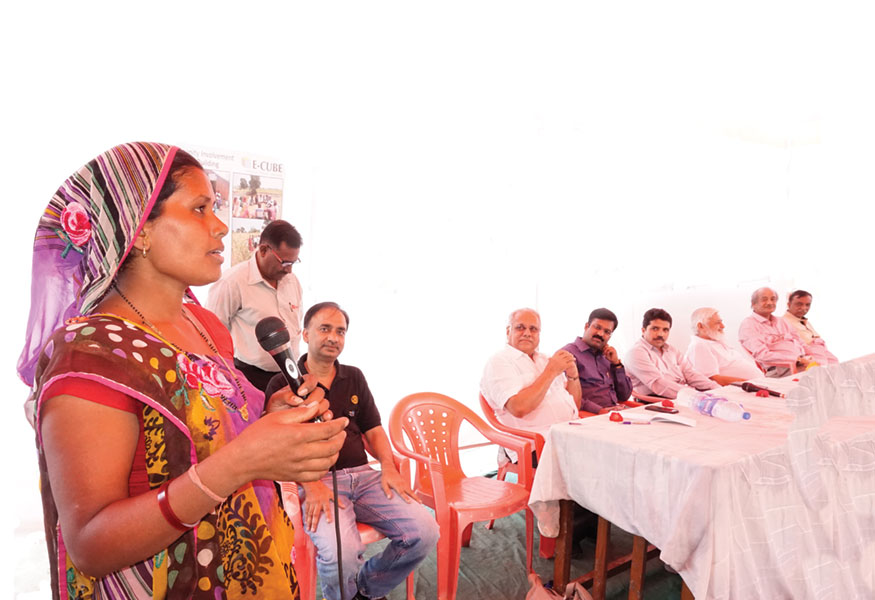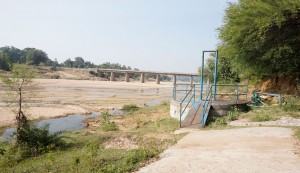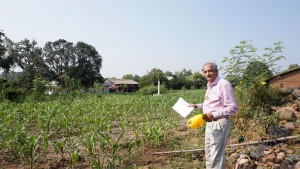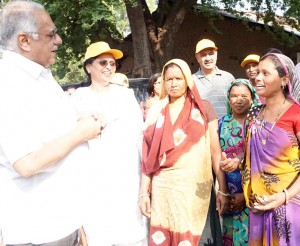Twinkle in the eye of Leelaben

I don’t know your name Collector Sahib but you are very welcome in our village,” says Leelaben, the 30-year-old woman, handling the mike like a seasoned speaker and addressing a meeting of 100-odd co-villagers where the Collector of Chhota Udepur District Jenu Devan, RI Director Manoj Desai, Rotarians from RC Baroda Metro and executives of the Shroffs Foundation Trust (SFT) have gathered.
“Let me confess at the outset that we have not brought rocket science here; all we have done are simple interventions, such as building check dams, a couple of community wells, some water harvesting measures in 10 ‘model houses’ we created with cattle sheds, bio gas plants etc,” says past president and Charter member of the club Sunil Vakil.
This project was conceived a couple of years ago with RC Baroda Metro getting involved with a global grant project of $105,000 (with the rupee then at 62 to a USD, the amount was Rs 65 lakh) along with RC Ashiya, Japan. The Club had raised Rs 18 lakh. With the SFT being active in this tribal belt of Gujarat for over two decades, and already running several interventions in Katarvad such as farm schools, it was chosen as a partner.
Vakil, a Chartered Accountant, and a tough taskmaster when it comes to accounting for every penny of Rotary money raised, and who ran a tight ship during the rebuilding of villages after the 2001 Kutch earthquake, has managed to save Rs 10 lakh from the funds available. At the meeting he promised the villagers that this money would all be spent on bettering their lives, but only after the Rotarians watch and assess for some time how the new facilities created are being utilised.
Land-owning tribals
Fortunately, all the families in Katarvad own land — sale of tribal land to non-tribals is prohibited under law — with landholding being mostly between 1–4 acres. Another plus is that the village is on the banks of the Aursung River, a virtual tributary of the Narmada. The village also receives good rainfall — an annual average of 40 inches. “But the rainfall is limited to four months (June–September) and like over 80 per cent of India, these villagers too are dependent on rains,” says Vakil. To add to this, most of the land is undulating so the water runs off faster.
Katarvad was chosen because the Rotarians found that with simple interventions and harnessing of natural resources, household incomes could be improved dramatically and so sustainable economic and community development was possible. Also, as the SFT had already done a complete aerial survey with the State geological department, and had complete data on crucial indicators such as soil condition, additional livelihood opportunities etc, it was felt that this could be developed as a model village, which could later be replicated.
Simple interventions
As there are no natural water bodies here, the first intervention was to level the undulating land and put in gulley plugs (big stones) at exit points to ensure that the rainwater doesn’t run off. Next they had to ensure water for the fields for at least 8–10 months, so two check dams were built. Says Club President Agam Shrivastava, “The topography of the command area of this project is such that small streams flow through certain parts of the village’s fields, so the check dams could obstruct the monsoon water. This also improves the sub soil water content.”
But since these check dams could service only a part of the command area, two group wells were built; normally water is available at 40 ft but these went down to 60 ft to take care of deficient monsoons. As luck would have it, this very year, after 15 years of good rainfall, the recent monsoon was deficient, but the villagers have adequate water for their farming needs. Of the total area, only 31.82 hectares are cultivable.
To take care of the remaining area, a lift irrigation system has been set up by installing water pumps on the river bed and then water is distributed to the dry areas through piped supply.


Empowering tribal women

Prior to the meeting I’ve asked to interview the beneficiaries of the E cube project in Katarvad. At one of the farm schools of the Shroffs Foundation Trust, set up by the Shroffs Family Charitable Trust, Leelaben (30), captivates me with her bright smile and intelligent sparkling eyes. Later, as she holds the mike and speaks with admirable confidence before the District Collector Jenu Devan and a bunch of Rotarians led by RI Director Manoj Desai, it is difficult to imagine that she is a tribal woman from a backward Indian village where all the 212 families don the BPL label.
She helps run the family farm with husband Karsanbhai, growing paddy, maize, etc.Having passed Class 10, she is now the primary social worker and trainer in the farm school — the Trust runs 72 in this region — she effortlessly speaks of “SRI,” (which CEO Vikas Vaze explains as ‘systematic rice intensification’), vermi composting and bio fertilisers such as “Amrutpani and Brahmastra!”
In the presence of other women farmers that she has trained, she explains how through SRI, paddy yield from the land can be scaled up significantly. “This is a scientific way to get more produce with fewer seeds and less water.” She trains both male and female farmers at this ‘school’ in the benefits of using bio fertilisers and other scientific methods of farming.
We all watch in fascination as she concludes her address at the Rotary meet asking village women to stop allowing others to divide them, and grab with both hands the opportunities the SFT and Rotary were giving them to improve their lives and livelihood. Like a seasoned activist she says, “When we women are given some education, training and freedom to participate in developmental and economic activity of the village, we can collectively do so much. But very often we allow others to suppress us and are pushed to the background with menial jobs.”
As she winds up her speech with a call to the women to unite to change the entire village’s future, a relieved Devan is grateful to the Rotarians for solving one of his dilemmas. He reveals that often at meetings presided over by the Chief Minister to explain government initiatives for women’s empowerment, his dilemma is to get a rural woman to explain how these have empowered women. But the problem is that the female beneficiaries are very nervous at such meetings and unable to speak. “But now I know exactly where to find such a confident and articulate woman,” he says amidst applause.
But my main takeaway is what Leelaben had told me earlier. Her eight-year-old daughter goes to a school and her toddler son is yet to enter one. But she swears that both her daughter and son will get equal and good quality education!
Model houses
Next, 10 houses were chosen for development as “model houses” at a cost of Rs 1.1 lakh for each. The existing parnala of small channels on the rooftops were used or developed for water harvesting. Through these channels water flows into a small storage tank and is drawn out through a hand pump installed close by. Each of these homes is also provided with a cattle shed and a biogas facility. The cowdung and other bio-waste collected are turned into cooking fuel for the home.
As we drive into Katarvad, passing on the way the majestic expanse of the Narmada canal brimming with water, I don’t have to depend on the Rotarians’ testimony on the water availability in the village, where most parts wear a huge green blanket. The enthused villagers are ready with dholak and all, to welcome their benefactors — officials of SFT and the Rotarians — as well as their Collector. There is water available in the check dams and the community wells. Enthused by the wells put up by the Rotarians, with local shramdan, the villagers themselves have put up 10 more community wells.
During the drive SFT CEO Vikas Vaze explains to me how this region is one of the poorest of poor blocks in the Chhota Udepur District carved out of Baroda district. “When we came here, the villagers, who mainly grow paddy, bajra, maize, cotton, were able to get only a single crop and were totally dependent on rain-fed agriculture. After 3–4 months when they had no water for their fields they would migrate to neighbouring areas for work.”
As entire families migrated, taking even their animals with them as there was no fodder, the children were deprived of even primary education. Things were so bad initially, that an entire block would get barely 3–4 litres of milk a day “and we had to even carry our own milk for making tea,” he adds.
But today Leelaben and other women from the village can ensure that they get at least two litres of milk everyday from their cattle. Most of it is consumed in the home; “these are desi animals; that is why the milk supply is small. But when we have surplus, we sell it to the dairy,” says Leelaben, who has four animals.
Dhanjibhai, another farmer who owns 3 acres of land grows not only paddy and maize, but also vegetables such as brinjals, tomatoes, chillies and palak, which he markets. Adds Leelaben, “This year, for the first time we used natural fertilisers and you should have seen the fresh green leaves and the quality of the watermelons we grew and sold!”
Long term impact
Now with increased availability of water and micro irrigation facility the villagers will be able to harvest multiple crops every year. Dhanjibhai with three acres of land and Samdakaka with five acres confirm that their soil has become much healthier and softer by avoiding chemical fertilisers and using the natural fertilisers prepared at the SFT farm schools. “What is more, instead of irrigating the land six times for a crop, we now have to do it only three times, as bio fertilisers help the soil retain moisture,” says Samdakaka. But he is most happy that compared to the 2–3 bags of rice or maize they earlier got from one acre of land, now the produce is 8–10 bags.
Add to this the value addition given by the SFT at its farm schools, where samaj shilpis (social architects) such as Leelaben are given special training in modern farm techniques, bio manure, special seeds, etc, incomes are expected to even quadruple. “Now we have the confidence that by using proper farming techniques, the yield can go up to 15 bags per acre,” he smiles.
So what next?
“For at least a year Agam and I will visit the village along with other committee members to see that the resources we’ve created are shared equitably,” says Vakil. Also, being an expert in socio-economic assessment — he has done such analysis for a Rotary project in the Philippines — he feels this is a perfect case for such an assessment. “We’ll take the help of students and the Social Work faculty in the MS University to do such a study and then build a replicable model on long term impact of such interventions,” he adds.
While Desai announces construction of girls’ toilets in the region, Shrivastava adds that the club has undertaken to build under Swachh Bharat 100 toilet blocks in schools in the region, mainly for girls. “The Gujarat Government has asked us to uplift a whole village. After seeing our work, now several MPs and MLAs are giving us their adopted villages for uplift, offering us their funds too!”
Ultimately the sustainability and long term impact of this project named E cube — to represent the three Es — empathise, energise and empower — will determine its success. But the USP of this project, as sums up Vakil, is its simplicity. “As I said, it is not rocket science we brought here, but only simple intervention and scientific approach in harnessing available resources.” Water harvesting, land leveling, group wells, lift irrigation … all simple interventions which were available for thousands of years but somehow the Rotarians became the catalysts and tapped these resources.
“Did you notice the twinkle in Leelaben’s eyes as she spoke to you or when she addressed the gathering? This is the inner spirit that most Indians have. To bring out that twinkle in the eye is an opportunity that Rotary gives … it is the service aspects of Rotary that I enjoy the most. Otherwise temperamentally I am not fit for Rotary,” he smiles.
Pictures by Rasheeda Bhagat
